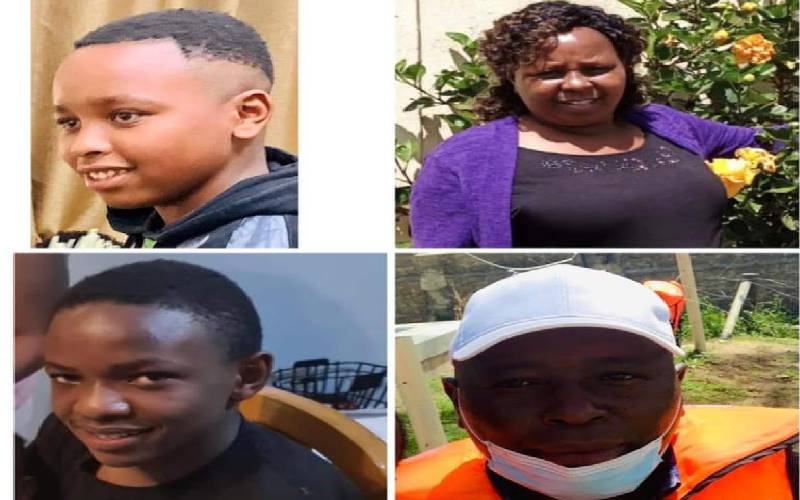
Nicholas Njoroge (bottom right), his wife Wanjiku and their two children who were murdered at their home in Kiambaa Constituency, Kiambu County on January 6. [Courtesy]
The day-long postmortem examination procedure at Kenyatta Memorial Funeral Home in Kiambu County, overseen by Chief Government Pathologist Johansen Oduor yesterday, shed more light into the painful and despairing last moments of the four family members and one worker murdered in Kiambu last week.
The illuminating details could be crucial in helping investigators unravel the puzzling case, in which the murdered family’s eldest son, Lawrence Waruinge, has been arrested and arraigned in court as a suspect.
Oduor told media yesterday that from his assessment, the attacker seemed especially bitter with the father, Nicholas Njoroge, and his younger son, judging by the particularly vicious nature of wounds the attacker inflicted on the two victims.
“The person who got the most injuries was the father and son actually. I cannot remember exactly how many, but they had very many stab wounds, with severed necks. It is like the person who killed the two was doing it with a lot of anger,” Oduor said yesterday.
He also revealed that the mother, Wanjiku Njoroge, appeared to have put up the most resistance to the attacker, out of all the victims, given her broken upper arms.
Oduor revealed: “The victims resisted, especially the mother. She had broken upper arms, like someone who is trying to block a blow from a blunt object.”
The other family members, Oduor stated, had stab wounds on the hands, an indicator that they were trying to block the assailant from attacking them with a sharp object.
Oduor also noted that from the bruises on the head of the father, it is likely that he injured his head during the attack.
However, unlike the defence marks on the family members, Oduor revealed that the labourer, who was murdered in a separate house within the compound, was likely ambushed by the attacker, meeting his death by surprise.
Oduor narrated that his analysis had shown that the labourer suffered blunt trauma to the head, adding that further assessment showed the possibility that the assailant attacked the labourer by surprise and as a result, denied him the opportunity to put up much resistance or defence.
Oduor further told media that from his assessment, all the five victims died from multiple injuries, caused by both blunt and penetrating trauma. He further noted that the injuries were similar, in particular, stab wounds to the chest and slashed necks, in addition to significant loss of blood. He also noted that the victims suffered blunt trauma to the head.
“We found multiple injuries that were similar. They were mainly stab wounds, which were multiple on the chest. Some of them had slash wounds on the neck and there were multiple blunt trauma to the head. Those were the external findings. Internally, there were head injuries, there was bleeding. All of them died due to multiple injuries which were caused by blunt and penetrating trauma and also significant loss of blood,” Oduor revealed.
Since the injuries were similar across the victims, Oduor stated, it is likely that the same weapon was used to murder the five victims
“It is likely that the weapon which was used was used on all the victims. If you look at the measurements of the stab wounds, they were varying from about three centimetres to four centimeters in all the victims, so this shows us that it is likely that the same weapon was used on all of them,” Oduor stated.
Penetrating trauma
However, he added that since the victims suffered both blunt and penetrating trauma, multiple weapons were used to kill them, but the same weapon was used to inflict penetrating trauma.
He said while it is likely the same weapon was used to kill the victims, he could not ascertain whether there was one attacker or more than one with similar weapons, and that it was up to investigators to solve the puzzle.
However, it is likely that more details about the murders will unravel in the coming days since in addition to Oduor’s postmortem procedure, analysts from the Government Chemist’s Forensic Team collected more evidence for analysis from the bodies of the victims.

